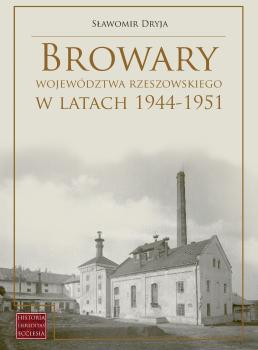Browary województwa rzeszowskiego w latach 1944-1951
Słowa kluczowe:
polish brewing industry, brewery, changes in ownership in 1944- 1950Streszczenie
BREWERIES OF THE RZESZÓW PROVINCE IN THE YEARS 1944-1951
The breweries in Rzeszów region were among the earliest to be opened in post-war Poland. Production was re-launched Przemyśl, Strzyżów and Węgierka as early as August, only slightly later in Łańcut, and in Tarnobrzeg in September. The brewery in Zarszyn restarted operations in December; in Zaczernie first batches were brewed in February 1945. The plant in Dzików Stary was the last to be re-opened. This happened in April or May 1945. In 1944, the breweries in Rzeszów region made 7500 hectolitres of beer.
Generally speaking, ownership transformation took two different directions. Breweries connected with the activities of parcelled out land estates were handed over as ‘residue’ for administration by the State Land Fund managed by the Minister of Agriculture and Land Reform. Such was the fate of the breweries in Strzyżów, Węgierka and Zaczernie. Over time, they were earmarked for administration by the cooperative sector. Other breweries, separated from land estates (Łańcut) or formerly owned by Jews (Dzików Stary, Przemyśl, Zarszyn), were managed by Temporary State Administration.
Similar processes took place throughout the country, subject to obvious differences between lands annexed to Poland in 1945. As a consequence, the structure of the Polish brewing industry was shaped in three sectors: national, cooperative and private. Breweries controlled by the state were grouped together in a central industrial association subject to the Ministry of Supply and Trade. Breweries ran by cooperatives were mostly supervised by the Ministry of Agriculture and Land Reform. Private establishments had to remain members of the Association of Private Breweries in Poland. This tripartite structure operated in the context of allocated and centrally supervised quotas of raw materials, as well as production plans and markets imposed by the state.
In 1946, there were 123 breweries registered in Poland. The national sector played the leading role, and the majority of state breweries were large (production volumes above 50,000 hl per year) or largest plants (more than 100,000 hl per year). This sector supplied over 90% of all beer produced in Poland. In terms of quantity, the most numerous group were small breweries (annual production volume up to 15,000 hl) – a total of 78 (63.4%), half of which belonged to the state. There were 24 (19.5%), medium- sized breweries (production volume 15,000 to 50,000 hl), 2/3 of which owned by the state.
Rozdziały
-
TABLE OF CONTENTS
-
I. Zakres pracy i podstawy źródłowe .......... 7
-
II. Definicja zakresu terytorialnego województwa rzeszowskiego .......... 9
-
III. Podstawy prawne przemian własnościowych w latach 1944-1950 .......... 11
-
IV. Struktury organizacyjne przemysłu fermentacyjnego .......... 21
-
V. Podatki i opłaty obciążające przemysł piwowarski .......... 29
-
VI. Rozwój browarnictwa w regionie rzeszowskim w latach 1900-1939 (1944) .......... 35
-
VII. Działania wojenne w regionie rzeszowskim w 1944 roku .......... 45
-
VIII. Browar w Dzikowie Starym .......... 51
-
IX. Browar w Łańcucie .......... 79
-
X. Browar „Wiktoria” w Przemyślu .......... 109
-
XI. Browar w Strzyżowie .......... 147
-
XII. Browar w Tarnobrzegu .......... 163
-
XIII. Browar w Węgierce .......... 221
-
XIV. Browar w Zaczerniu .......... 243
-
XV. Browar w Zarszynie .......... 267
-
XVI. Browar w Trzcinicy – życie po śmierci .......... 307
-
XVII. Podsumowanie .......... 315
-
ANEKS. Słownik pojęć piwowarskich stosowanych na Rzeszowszczyźnie w latach 1944-1945 .......... 327
-
Bibliografia .......... 409
-
Spis ilustracji .......... 417
-
Indeks nazwisk .......... 433
Downloads
Bibliografia





